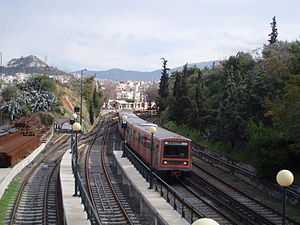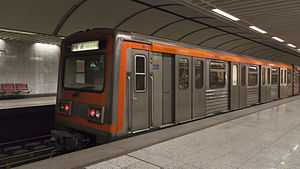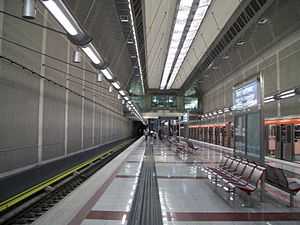Athens Metro
.svg.png) | |||
|
Athens Metro subway train (1st generation stock) | |||
| Overview | |||
|---|---|---|---|
| Native name | Μετρό Αθήνας | ||
| Owner | Attiko Metro S.A. | ||
| Locale | Greater Athens and East Attica | ||
| Transit type | Rapid transit | ||
| Number of lines | 3 | ||
| Number of stations | 61 (6 more under construction) | ||
| Daily ridership | 1,353,000[1] | ||
| Annual ridership | 493,800,000 (2013) | ||
| Website | STASY S.A. | ||
| Operation | |||
| Began operation | 1904 | ||
| Operator(s) | Statheres Sygkoinonies S.A. | ||
| Number of vehicles | 294 railcars | ||
| Technical | |||
| System length |
25.6 km (15.9 mi) (Line 1)[2] 58.9 km (36.6 mi) (Lines 2 & 3)[1] 84.5 km (52.5 mi) (Total; includes 20.7 km (12.9 mi) of suburban rail[1]) | ||
| Track gauge | 1,435 mm (4 ft 8 1⁄2 in) standard gauge | ||
| Electrification | |||
| Top speed | 80 km/h (50 mph) | ||
| |||
The Athens Metro (Greek: Μετρό Αθήνας, Metró Athínas) is a rapid-transit system in Greece which serves the Athens conurbation and parts of East Attica. It incorporates the former Athens-Piraeus Electric Railways (ISAP), which opened as a conventional steam railway in 1869, and which was electrified in 1904 and is now part of Line 1. Beginning in 1991, Attiko Metro constructed and extended Lines 2 and 3[3] and the Attiko Metro Operations Company (AMEL) operated these lines from 2000 to 2011.[4] The metro network merged in 2011 when the Greek government created the Urban Rail Transport Company (STASY), a subsidiary of the Athens Urban Transport Organization (OASA).
History
Athens-Piraeus Railway
Until 28 January 2000, Line 1 was the only rapid-transit line in Athens and Piraeus. The Athens and Piraeus Railway Company (SAP) opened the line on 27 February 1869 as a steam railway between Piraeus and Thiseio. It was electrified in 1904, and extended in stages to Kifisia in 1957.
From 1976 to 16 June 2011, the Athens-Piraeus Electric Railway Company (ISAP) operated Line 1 independently from the rest of the metro and tram networks.[5] Unlike Lines 2 and 3, it runs almost entirely above ground.
1990s projects
Since the current Line 1 opened the government has proposed many expansions to the subway network, including a 1963 plan for a fourteen-line subway network.[6] Construction of Lines 2 and 3 began in November 1992 to decrease traffic congestion and improve Athens' air quality by reducing its smog level.[3] Both lines were constructed underground. Lines 2 and 3, built by Attiko Metro and operated until 2011 by Attiko Metro Operations Company, are known respectively as the red and blue lines and were inaugurated in January 2000. Line 3 was extended to the Eleftherios Venizelos International Airport in summer 2004, and Line 2 was extended to Anthoupoli and Helliniko in 2013.
Consolidation
Until 17 June 2011,[5] the operational management of the Athens Metro network was similar to that of the London Underground network before the creation of the London Passenger Transport Board and the absorption of the Metropolitan Railway on 1 July 1933. The Greek government attempted to absorb ISAP into Attiko Metro under Law 2669/1998 so the latter would be responsible for the whole network,[7] but this initiative failed. Athens Metro operations were consolidated when the Greek government enacted Law 3920/2011,[8] replacing AMEL, ISAP and Athens Tram with Urban Rail Transport (STASY) (Greek: ΣΤΑΣΥ Α.Ε.), a subsidiary of OASA.[9]
Infrastructure
Lines and stations
The modern incarnation of Line 1 is 25.6-kilometre (15.9 mi) long,[2] and serves 24 stations. Together, Lines 2 and 3 are 58.9-kilometre (36.6 mi) long (including 20.7 kilometres (12.9 mi) of suburban rail line from Doukissis Plakentias station to the Airport on Line 3), and serve 41 stations.[1][10]
| Line | Map colour[I][11] | First section opened |
Elec. | Latest section opened |
Latest station opened | Route | Length (km, mi) | Sta. | ||||
|---|---|---|---|---|---|---|---|---|---|---|---|---|
| |
Green | 27 February 1869 | 1904 | 10 August 1957 | 6 August 2004 (Nerantziotissa) |
Piraeus – Kifisia | 25.6 km (15.9 mi)[2] | 24 | ||||
| |
Red | 28 January 2000 | 2000 | 26 July 2013 | 26 July 2013 (Elliniko)[12] |
Anthoupoli – Elliniko | 17.9 km (11.1 mi) | 20 | ||||
| |
Light Blue+ | 28 January 2000 | 2000 | 14 December 2013 | 14 December 2013 (Agia Marina) |
Agia Marina – Doukissis Plakentias/Airport | 41 km (25.5 mi) | 21 | ||||
| + Dark blue on signage. | ||||||||||||
.svg.png)
The three-line Athens Metro network serves 61 stations. It owns and operates 57 of them, and OSE owns the remainder on the airport section. The network has four metro interchanges, enabling the lines to interchange with each other at least once. Each line also has at least one station connecting with the Proastiakos Suburban Railway and Athens Tram; however, Line 3 will not have a direct interchange with TrainOSE until the extension to Dimotiko Theatro opens.
Line 2 and the Attiko Metro portion of Line 3 is entirely underground. Line 1 is primarily in the open, with a tunnel section in central Athens. The airport section of Line 3, east of the tunnel portal near Doukissis Plakentias, is open. In the tunnel sections up and down lines share a common tunnel, except for approaches to stations with an island platform (such as Egaleo).
The network uses standard gauge electric trains which run on 750 V DC third rail. Line 1 has historically had its own fleet, and the airport section requires trains which can use overhead lines of 25 kV AC, 50 Hz. Nevertheless, there are rail connections between Lines 1 and 2 near Attiki and between Lines 2 and 3 near Syntagma. Train maintenance facilities are located at Attiki, Faliro, Irini, Piraeus and Thiseio for Line 1, and Doukissis Plakentias, Eleonas and Sepolia for Lines 2 and 3.
As of April 2008 the blue line (Line 3) was 16.4 km long,[13] not including the suburban railway line to the airport or (as of February 2008) 21.2 km of the line it shares with the Athens suburban railway system. As of July 2008, the red line (Line 2) was 10.9 km,[13] bringing the overall length of the green, red and blue lines to approximately 74 km. The Athens Metro's three lines carry approximately 1,353,000 passengers daily.[1]
Rolling stock
The Athens Metro uses standard gauge trains, and classifies rolling stock by "batch" for Line 1 and "generation" for Lines 2 and 3 because ISAP and AMEL used different classification systems for rolling stock before consolidation. Six types of rolling stock operate on the network, all equipped to run on 750 V DC third rail; however, only seven second-generation trains can serve Line 3 from Doukissis Plakentias to Airport. Differing signal systems prevent batch stock from running on Lines 2 and 3 and generation stock from running on Line 1.
The eighth batch (introduced in 1983) is the oldest rolling stock in passenger service, while the second generation (introduced in 2003) is the latest rolling stock in passenger service. The eighth- and tenth-batch stock is externally similar, but the former has split-flap headsigns in Johnston typeface and a cream-and-green interior colour scheme.
| Line | Stock | Image | Introduced |
|---|---|---|---|
| |
8th-batch stock |  |
1983 |
| |
10th-batch stock |  |
1993 |
| |
11th-batch stock |  |
2000 |
| |
1st-generation stock |  |
2000 |
| |
2nd-generation stock | |
2004 |
| |
3rd-generation stock | .jpg) |
2014 |
- First series (delivery): 28 six-car electric multiple units made by Alstom–Siemens–Adtranz (2000); maximum speed 80 km/h[14]
- Second series (delivery): 21 six-car EMU made by Hanwha-Rotem-Mitsubishi (2004).[15] Seven of these trains can also operate on OSE lines with 25 kV AC −50 Hz overhead electrification system and are used for airport service. All second-series trains are air-conditioned. Maximum speed 80 km/h
- Third series: Athens Metro ordered 17 additional trains.
- Four service hybrid locomotives made by Kaelble-Gmeinder-Siemens. They can operate from a third-rail 750 V DC system or their own diesel generators. They have a B-B configuration, with a maximum power of 550 kW under diesel traction and 600 kW under electric traction.[16]
- One road-rail Unimog
| Batch | Year | Configuration | Type | Numbering | Description |
|---|---|---|---|---|---|
| 1st | 2000 | DT-M-MD+MD-M-DT | DT | A01-A56 | 56 EMU-3 "half-trains" operating as 28 EMU-6 trains. Made by Alsthom-Siemens-ADtranz. MD railcars have an auxiliary driving facility used only for shunting. |
| M | B01-B56 | ||||
| MD | C01-C56 | ||||
| 2nd (DC) |
2003–2004 | D-T-M+M-T-D | D | D201-D228 | 28 EMU-3 "half-trains" operating as 14 EMU-6 trains. Made by Hanwha-Rotem-Mitsubishi. |
| T | T201-T228 | ||||
| M | M201-M228 | ||||
| 2nd (DC/AC) |
2003–2004 | D-T-M+M-T-D | D | D251-D264 | 14 EMU-3 "half-trains" operating as 7 EMU-6 trains. Made by Hanwha-Rotem-Mitsubishi, can also operate on 25 kV AC, 50 Hz lines. |
| T | T251-T264 | ||||
| M | M251-M264 | ||||
| 3rd | 2012–2013 | D-T-M+M-T-D | D | D301-D334 | A contract for 17 air conditioned EMU-6 trains was signed on 2009-09-16 with Hanwha-Rotem.[17] 34 EMU-3 "half-trains" entered service as 17 EMU-6 trains in June 2014. |
| T | T301-T334 | ||||
| M | M301-M334 |
Railcar codes: DM: driving motor car, DT: driving trailer, M: motor car, T: trailer, MD: motor car with auxiliary driving facility.
Signalling
Line 1 uses two-aspect red/green home signals, yellow/green distant signals and a passenger information system (PIS). The current system replaced 1950s-era semaphore signals.
Lines 2 and 3 use the Alstom automatic train supervision system (ATS) and a passenger information system (PIS). Two-aspect red/white colour signals are used at points and junctions only.
Ticketing policy
As of September 2014, purchased tickets are valid for 70 minutes after validation, and can be used for unlimited trips on the network (lines 1, 2 and 3) and on all other public transport in Athens (buses, trolleybuses, trams and the urban part of the suburban railway between Piraeus, Magoula and Koropi—excluding the airport). Passengers must validate their tickets once, using the machines at the station entrance at the start of their first trip.[18]
There are daily and weekly tickets, and monthly cards. Fares are checked frequently, and passengers who do not have a validated ticket or monthly card are required to pay 60 times the price of a standard ticket.
Airport fares
Travel to and from the Athens International Airport costs €8; in February 2011, the round-trip fare (within 48 hours) was €14. There are also two- and three-person one-way fares.
Archaeological excavations and exhibits

During construction of the metro tunnels, artifacts of archaeological interest were discovered and rescue archaeology was employed. Teams of archaeologists worked ahead of, then with, engineers for six years, protecting and recording archaeological finds (streets, houses, cemeteries, sanctuaries, public workshops, foundry pits, kilns, aqueducts, wells, cisterns, drains and sewage tunnels). This afforded new insight into the city's ancient topography, through unprecedented infrastructure development combined with the study and preservation of archaeological data. Exhibitions of ancient artifacts or replicas are found at a number of metro stations, including Monastiraki and Syntagma.
Plans
| Line | Map colour[I][11] | First section opened |
Elec. | Latest section opened |
Latest station opened | Route | Length (km, mi) | Sta. |
|---|---|---|---|---|---|---|---|---|
| |
Orange | Proposed | Proposed | Proposed | Proposed | Petroupoli – Ethniki Odos | 33.0 km (20.5 mi)[19] | 29[19] |
Line 4
A line between Alsos Veikou and Maroussi was planned, but was unfunded as of May 2009.[20] On 4 November 2010, it was announced that a call for bids for construction of the western branch would be issued in late 2011. Geotechnical investigations are occurring at a number of locations on the proposed route.
According to the Metro Development Study, two lines would be constructed as branches of existing lines: a Line 2 branch from Panepistimio to Alsos Veikou and a Line 3 branch from Panormou to Maroussi. Further study showed that construction of a separate line joining the branches is preferable.[21] The proposal also recommends lighter rolling stock than the type used in Lines 2 and 3, which would operate without a driver. The proposed route for Line 4 is:

- Alsos Veikou
- Galatsi
- Kypseli
- Dikastiria
- Alexandras
- Exarhia
- Panepistimio (new station, with an underpass connection to existing Line 2 station)
- Kolonaki
- Evangelismos (existing Line 3 station)
- Kaissariani
- Ano Ilissia
- Zografou
- Goudi
- Katehaki (existing Line 3 station)
- Faros
- Filothei
- Sidera
- O.A.K.A.
- Paradissos
- O.T.E
- Maroussi (existing Line 1 station)
See also
- ISAP (Line 1)
- Athens Mass Transit System
- Thessaloniki Metro
Notes
I. ^ As of October 2012, none of the organisations behind the construction or operation of the Athens Metro specify the exact line colour values for web or print, but they agree on a general colour scheme for identifying lines.[11][22]
References
- ↑ 1.0 1.1 1.2 1.3 1.4 "Homepage - The Company - Attiko Metro S.A.". Attiko Metro S.A. Retrieved 2014-06-02.
- ↑ 2.0 2.1 2.2 "Homepage - The Company - Historic Data - Transit in Athens". Attiko Metro S.A. Retrieved 2014-06-02.
- ↑ 3.0 3.1 "AttikoMetro Inside – Base Project". Attiko Metro S.A. 9 September 2012. Retrieved 3 October 2012.
- ↑ Law 2669/1988, Government Gazette Issue A 283/1998-12-18, Part 7, paragraph 2.
- ↑ 5.0 5.1 "Urban Rail Transport SA (STASY SA): Urban Rail Transport S.A". Urban Rail Transport S.A. Retrieved 2 October 2012.
- ↑ Hekimoglou, Achilleas (24 August 2013). Οραμα για 14 γραμμές Μετρό στην Αττική από το 2000 (in Greek). Το Βήμα (To Vima). Retrieved 25 September 2013.
- ↑ "Law 2669/1998". Εφημερίδας της Κυβερνήσεως (in Greek) (Athens: Government of Greece) A (283). 18 December 1998. Retrieved 24 September 2013.
- ↑ Law 3920, Government Gazette issue A-33, 3 March 2011.
- ↑ Ministerial Decision 28737/2637, Government Gazette issue B-1454, 17 June 2011
- ↑ "Homepage - Construction of the Athens Metro - Projects in Operation - Base Project". Attiko Metro S.A. Retrieved 2014-06-02.
- ↑ 11.0 11.1 11.2 "Athens Metro Regulatory Plan" (PDF). Attiko Metro S.A. 30 January 2012. Retrieved 29 August 2012.
- ↑ "Urban rail news in brief – May 2013". Railway Gazette International. 3 May 2013. Retrieved 21 June 2013.
- ↑ 13.0 13.1 "AMEL – Athens METRO operation:OPERATION". Amel.gr. 14 February 2009. Archived from the original on 24 April 2009. Retrieved 4 May 2009.
- ↑ G. Nathenas, A. Kourbelis, T. Vlastos, S. Kourouzidis, V. Katsareas, P. Karamanis, A. Klonos, N. Kokkinos (2007). Από τα Παμφορεία στο Μετρό (in Greek) 2. Athens: Μίλητος (Militos). pp. 703–708. ISBN 978-960-8460-91-1.
- ↑ http://www.ekathimerini.com/4dcgi/_w_articles_wsite1_1_05/06/2014_540357
- ↑ N. Sbarounis (December 2002). "Hybrid locomotives of Athens Metropolitan Network (Greek: Υβριδικές Ηλεκτράμαξες του Μητροπολιτικού Δικτύου Αθηνών)". Sidirotrohia (Greek: Σιδηροτροχιά) (in Greek) (23): 30–31.
- ↑ ATHENS METRO – Completion of the tender for the supply of 17 new trainsets for the Athens Metro (16/09/2009)
- ↑ 70min flat fare ticket for all Mass Transit Modes
- ↑ 19.0 19.1 "Line 4", AttikoMetro Inside (Attiko Metro), 31 December 2010, retrieved 19 July 2012
- ↑ June 2008 issue of the free Attiko Metro magazine available in the stations
- ↑ "AttikoMetro Inside". Ametro.gr. Retrieved 4 May 2009.
- ↑ "Athens Public Transportation Map" (PDF). Athens Urban Transport Organisation. 26 July 2011. Retrieved 11 October 2012.
External links
| Wikimedia Commons has media related to Athens Metro. |
- Urban Rail Transport Company (STASY S.A.)
- Attiko Metro Company (Construction and Infrastructure)
- Athens Urban Transport Organisation (OASA S.A.)
- Hellenic Ministry of Public Works page on the Attiko Metro
- UrbanRail.Net – Athens Metro
- CityRailTransit – Athens railway map (real distance)
| ||||||||||
| ||||||||||||||||||